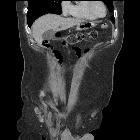Amyand hernia
















 nicht verwechseln mit: Schenkelhernie mit Appendix vermiformis
nicht verwechseln mit: Schenkelhernie mit Appendix vermiformisAmyand hernias (alternative plural: herniae) are a rare form of inguinal hernia in which the vermiform appendix is located within the hernial sac. They are seen in less than 1% of inguinal hernias.
It should not be confused with an appendix-containing femoral hernia, known as a De Garengeot hernia.
Terminology
The term applies to inguinal hernia containing appendix regardless of whether there are complications such as appendicitis .
Clinical presentation
The appendix may remain in an inguinal hernia without symptoms. If complications develop, an atypical presentation of acute appendicitis is expected, which may mimic incarcerated inguinal hernia.
Radiographic features
CT
- blind-ending tubular structure arising from cecum and extending into inguinal sac
- dilated lumen, wall enhancement and thickening, peri-appendiceal fat stranding are suggestive of acute appendicitis
Ultrasound
- extension of the appendix into the inguinal sac
- if acutely inflamed, the appendix is dilated, non-compressible, thickened and hypervascular
History and etymology
Claudius Amyand (c.1681-1740) was a French surgeon who performed the first successful appendectomy in 1735, on an 11-year-old boy who presented with an inflamed, perforated appendix in his inguinal hernia sac .
See also
Siehe auch:
- Appendix vermiformis
- Schenkelhernie mit Appendix vermiformis
- Inguinalhernie
- Littre´sche Hernie
- Lageanomalien der Appendix vermiformis
- Hernien der Leistenregion
- acute appendicitis in inguinal canal
und weiter:

 Assoziationen und Differentialdiagnosen zu Appendix in Leistenhernie:
Assoziationen und Differentialdiagnosen zu Appendix in Leistenhernie:



